Exploring the impact of biomechanics on stress management and mental toughness during competitive sports events
Abstract
Biomechanics plays a crucial role in optimizing athletic performance while mitigating physiological and cognitive stress in competitive sports. Stress-induced biomechanical inefficiencies contribute to movement instability, increased injury risk, and reduced mental resilience. However, limited research has integrated biomechanical, physiological, and neurophysiological assessments to provide a comprehensive analysis of stress adaptation in elite athletes. This study aims to quantitatively assess the impact of biomechanics on stress management and mental toughness using an integrated multi-modal approach. Specifically, it examines the relationship between movement efficiency, physiological stress markers, and cognitive load in high-performance sports. Three advanced measurement techniques were employed: (i) 3D Motion Capture and Force Plate Analysis to evaluate movement precision and force asymmetry; (ii) Heart Rate Variability (HRV) and Cortisol Quantification to assess autonomic nervous system regulation under stress; and (iii) EEG and fNIRS-Based Mental Load Measurement to analyze cognitive workload and neural adaptations. Data were collected under baseline, moderate stress, and high-stress conditions. Findings revealed a 44.4% decline in biomechanical efficiency, a 56.3% reduction in HRV-based autonomic regulation, and a 52.9% increase in cognitive workload under high-stress conditions. Increased joint angle variability, force asymmetry, cortisol elevation, and EEG beta power shifts were key indicators of stress-induced performance deterioration. The results underscore the necessity of integrating biomechanical optimization, stress management protocols, and cognitive resilience training in athlete development. This study highlights the interconnected nature of movement biomechanics, physiological stress regulation, and neurocognitive resilience. Future research should explore predictive modeling and real-time monitoring to enhance individualized stress-adaptive training strategies.
References
1. Maki KA, Goodyke MP, Rasmussen K, et al. An integrative literature review of heart rate variability measures to determine autonomic nervous system responsiveness using pharmacological manipulation. Journal of Cardiovascular Nursing. 2024; 39(1): 58-78. doi: 10.1097/JCN.0000000000001001
2. Betson J, Fein EC, Long D, et al. Feasibility of utilizing functional near-infrared spectroscopy to measure the cognitive load of paramedicine students undertaking high-acuity clinical simulations in Australia: a case study. Journal of Educational Evaluation for Health Professions. 2024; 21: 38.
3. Arivudaiyanambi J, Akshayaa N. Leveraging Functional Near-Infrared Spectroscopy for the Assessment and Prediction of Mental Workload. In: Proceeding of the 2024 IEEE International Women in Engineering (WIE) Conference on Electrical and Computer Engineering (WIECON-ECE); 2024. pp. 332–336.
4. Taralov, Zdravko Z., Kiril V. Terziyski, and Stefan S. Kostianev. “Heart rate variability as a method for assessment of the autonomic nervous system and the adaptations to different physiological and pathological conditions.” Folia medica 57.3/4 (2015): 173. doi: 10.1515/folmed-2015-0036
5. De Carlo M. Unveiling the Influence of Stress and Mental Workload on Our Brain: An fNIRS Analysis [PHD thesis]. Politecnico di Torino; 2023.
6. Kelly N. An examination of pressure, competition anxiety, and performance in sport using virtual reality. Available online: https://doi.org/10.34961/researchrepository-ul.26412085.v1 (accessed on 12 January 2025)
7. Zhang X, Lv X, Zhang H, et al. Research on Optimization Strategy of Athletes' Training Mental Fatigue Based on Nano Biomechanical Data Fusion Analysis. International Journal of Nanotechnology. 2022; 19(6–11): 924–937. doi: 10.1504/IJNT.2022.128978
8. McIntosh AS. Risk Compensation, Motivation, Injuries, and Biomechanics in Competitive Sport. British Journal of Sports Medicine. 2005; 39(1): 2–3. doi:10.1136/bjsm.2004.016188
9. Elliott B. Biomechanics: An Integral Part of Sport Science and Sport Medicine. Journal of Science and Medicine in Sport. 1999; 2(4): 299–310. doi:10.1016/S1440-2440(99)80003-6
10. Nigg BM. Biomechanics, Load Analysis, and Sports Injuries in the Lower Extremities. Sports Medicine. 1985; 2: 367–379
11. Penichet-Tomas A. Applied Biomechanics in Sports Performance, Injury Prevention, and Rehabilitation. Applied Sciences. 2024; 14(24): 11623.
12. Taoulilit Y. The Role of Biomechanical Analysis in Enhancing Athletic Performance and Reducing Injuries. Mujalt Al'uwras Lieulum Alriyada. 2025; 3(1): 63–72.
13. Aminova A. Improving the Methodology of Training Wrestling Sports Specialists. International Journal of Pedagogics. 2025; 5(1): 96–98. doi: 10.37547/ijp/Volume05Issue01-26
14. Ioana AC, Vasilica G, Alin L, et al. The Relationship Between Competition Stress and Biological Reactions in Practicing Performance in Athletics. Journal Sport and Performance. 2012; 12(1).
15. Chowdhury L. Mental Wellbeing Technologies in High-Performance Sport: Current Knowledge and Future Directions. Available online: https://openresearch.ocadu.ca/id/eprint/4193 (accessed on 2 February 2025).
16. Fung Y. Biomechanics: Motion, Flow, Stress, and Growth. Springer Science & Business Media; 2013
17. Starastsenka K. How Techniques That Help to Develop Mental Strength in Individual Sport Such as Tennis Can Be Applied to Dealing with Everyday Stresses and Challenges That Require Resilience. Available online: https://digitalcommons.sacredheart.edu/acadfest/2024/all/3/ (accessed on 2 February 2025).
18. Cady-McCrea CI, Lawlor MC, Rodenhouse TF, et al. The Rowing Spine: A Review of Biomechanics, Injury, and Treatment. World Neurosurgery. 2024; 187: 156–161. doi: 10.1016/j.wneu.2024.04.032
19. Simon D, Kleyer A, Bayat S, et al. Biomechanical Stress in the Context of Competitive Sports Training Triggers Enthesitis. Arthritis Research & Therapy. 2021; 23: 1–6.
20. Pelz B. The Neuropsychological Effects of Posture: An Analysis of the Influence on Human Biochemistry in the Context of Sports Psychology. Journal of Psychology and Neuroscience. 2024; 6(3): 1–7. doi:10.47485/2693-2490.1093
21. Chauhan VS. Neurophysiological Basis of Athletic Performance. Innovative Research. 2025; 106. doi:10.25215/9358095784.15
22. Saadati SA. Recent Innovations in Sports Physiology: Shaping the Future of Athletic Performance. Health Nexus. 2023; 1(2): 15–27. doi:10.61838/kman.hn.1.2.3
23. Plakias S, Georgia K. Neuropsychophysiological Aspects of Soccer Performance: A Bibliometric Analysis and Narrative Review. Perceptual and Motor Skills. 2024; 131(6): 2346–2368. doi: 10.1177/00315125241292969
24. Liu J, Yu H, Cheung WC, et al. A Systematic Review of Pathophysiological and Psychosocial Measures in Adaptive Sports and Their Implications for Coaching Practice. Heliyon. 2025; 11(2): e42081
25. Barua R. Unleashing Human Potential: Exploring the Advantage of Biomechanics in Sport Performance. In: Information Resources Management Association. 2025. pp. 409–436. doi:10.4018/979-8-3693-3952-7.ch015
26. Akhmad N, Maulidin M. Worldwide Developments in Sports Biomechanics Investigation: Consequences for Injury Avoidance, Athlete Efficiency, and Recovery—Scopus Bibliometric Examination. Musamus Journal of Physical Education and Sport (MJPES). 2025; 7(1): 88–102.
27. Zhao F. The Application of Sports Biomechanics in Sports Injury Prevention and Rehabilitation. Frontiers in Sport Research. 2024; 6(3). doi: 10.25236/FSR.2024.060320.
Copyright (c) 2025 Author(s)

This work is licensed under a Creative Commons Attribution 4.0 International License.
Copyright on all articles published in this journal is retained by the author(s), while the author(s) grant the publisher as the original publisher to publish the article.
Articles published in this journal are licensed under a Creative Commons Attribution 4.0 International, which means they can be shared, adapted and distributed provided that the original published version is cited.



 Submit a Paper
Submit a Paper
